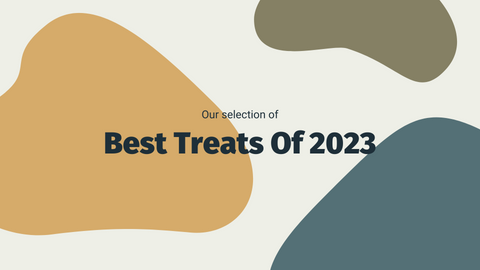There are many different types of dog food. Regular dry food, personalized freeze-dried, raw diets, wet food, home-cooked, and many more.
We’ll give you an overview of popular options, so you can navigate the maze of dog food offers. Important: If your puppy has digestion issues, always talk to your vet, and/or breeder too.
Dry food, also known as “kibble”
Dry food is usually produced through a process called “extrusion”. This means mixing all the ingredients together and heating them under pressure. The result then gets pushed through a machine that cuts it into the small kibble sized pieces.
There is a second, less common, procedure called "Fleischaftgarung". This procedure will not heat the ingredients to such a high temperature. Instead it will cook them in their own juice before pressing it into kibble pieces. These bits are usually “semi-most”.
Many dogs thrive on dry food. The promise of a dry food is that it is simple, and that you get a balanced diet for your dog “out of the box”. On the other side, some dogs develop allergies to certain ingredients in their diet. And some dogs might get bored of the same food every day.
What to look out for when choosing a dry food for your dog:
- High meat percentage
- Even though dry foods include many ingredients, meat is an important part of a dog's diet and it should be the very first ingredient listed.
- Ingredient splitting
- Be careful if you see “peas, pea flour and pea protein” listed as three separate items. In total they might surpass the meat content.
- High quality carbohydrates
- There are many ingredients that include carbohydrates. Vegetables are some of them. Grains are also a source of carbohydrates, though not all dogs tolerate grains well.
Wet food
There is often not a lot of difference between kibble and wet food in how nutritious they are. Some dogs prefer wet food as it tends to be more flavorful and smells more intensely. Wet food has a high moisture content, which will keep your dog hydrated. It's especially practical for dogs who drink very little water.
If you would like to opt for wet food, look out for the same details as in kibble. High meat percentage, disguised filler ingredients and high quality carbohydrates.
Some small stores cook their own wet food from real ingredients. If you would like to feed wet food, and the costs are fine for you, these are usually the least processed options.
Raw meat diet, also known as “BARF”
BARF stands for “Biologically Appropriate Raw Food”. This type of diet has surged in popularity over the last few years. The concept behind is "going back to basics". This trend started in human foods, and has now reached the diet of our favorite companions.
This diet consists of
- Meat
- Bones and/or cartilage
- Vegetables and fruits
- Grains (optional)
- Inner organs like liver, spleen, tripe, etc.
The benefit of this diet is that you know exactly what your dog eats. No byproducts hidden in marketing language. No ambiguous ingredients list to dissect. No big amount of filler ingredients (like grains).
You can easily tweak the diet to fit your dog’s needs and you rotate through different animal meats and vegetables to keep the meals well-rounded. This way you make sure your dog’s diet varies and they get all the nutrients they need.
The general benefits of BARF are:
- A Shinier coat
- It’s gentle on digestion
- Better oral hygiene
- Less and better smelling poop
Air-dried and freeze-dried food
Air-dried food uses a very old meat preserving technique. There are no preservatives and it is safe and convenient.
By freezing and other drying processes, raw ingredients lose their moisture. Freeze-dried food is the result of this process.
Air-dried and freeze-dried dog food is always based on raw meat. Therefore, the meat stays nutrient rich and natural.
Dog owners whose pets have allergies or intolerances often turn to raw, home-cooked or air-dried, as well as freeze-dried diets.
The benefits of air-dried and freeze-dried food are similar to the ones of feeding raw:
- A Shinier coat
- It’s gentle on digestion
- Better oral hygiene
- Less and not smelling poop
Fresh food
A newer trend offered by a few brands, or even prepared at home, is cooked food.
If you opt for a fresh dog food service, they will make sure to send you pre-portioned packages. These will contain all the necessary nutrients for your dog. All you will have to do is to unfreeze the daily portion.
If you choose to cook at home, you will have to take care of the nutrients and balancing the diet just like when opting for the raw BARF diet.
Some advantages of this type of diet are:
- A shinier coat
- It’s gentle on digestion
- Can lower inflammation in the body
- Can help with intolerances
- No risk of bacteria as all meat is cooked
Treats
You will realize early on that you need a lot of treats to reinforce the desired behavior. You will need to reward them for anything well done. Therefore, you will need a big amount of balanced, high quality treats available.
One handy way is to use your dog’s food as treats. This will help you train their food drive early on and teach them that exciting and delicious things come from you. You also have more treats at your disposal since you can only give a small amount of regular treats a day.
Treating is easy with the different dry food options, but more difficult with raw food or wet food. It is possible to feed the raw food using a silicone glove or a spoon, while wet food might be easiest to feed from a little travel size shampoo tube.
Test and try out what your dog likes. Observe what your dog perceives as high value treats, and you might notice differences in how they perceive the treats based on the environment they're in. For example, what food or treats they work for while in your living room, but ignore once outside.




Comments (0)
There are no comments for this article. Be the first one to leave a message!